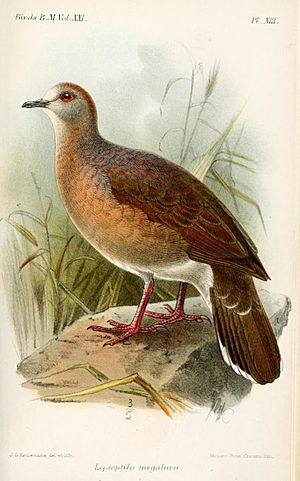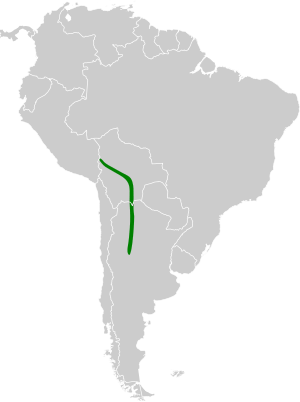Yungas dove facts for kids
Quick facts for kids Yungas dove |
|
|---|---|
 |
|
| Illustration by Keulemans, 1893 | |
| Conservation status | |
| Scientific classification | |
| Genus: |
Leptotila
|
| Species: |
megalura
|
 |
|
The Yungas dove (Leptotila megalura) is a type of bird that belongs to the Columbidae family, which includes doves and pigeons. It's also known as the white-faced dove or large-tailed dove. You can find this bird living in parts of Argentina and Bolivia.
Contents
About the Yungas Dove's Family Tree
Scientists group living things into categories to understand them better. This is called taxonomy. The Yungas dove is a "monotypic" species. This means it's the only species in its group, and there aren't any different subspecies (smaller groups within the species).
However, some people have thought that the doves living in the southern part of its range might be a separate subspecies. The Yungas dove is very closely related to the grey-fronted dove (L. rufaxilla). Scientists call these two "sister species" because they share a common ancestor.
What the Yungas Dove Looks Like
The Yungas dove is about 29 to 32 centimeters (11 to 13 inches) long. An adult bird has a grayish forehead and a bluish-gray crown on its head. Its eyes are very dark and are surrounded by white feathers. The rest of its face is a light yellowish-brown or pinkish-brown color.
The upper parts of its body and its tail are a dark reddish-brown. Its neck and upper back have a purple shine. The chest and sides of the neck are a grayish-pink, which gets lighter and turns white on its belly. Male and female Yungas doves look very similar. Young doves are not as brightly colored, and the feathers on their wings look a bit scaly.
Where the Yungas Dove Lives
The Yungas dove lives in the Yungas region. This area is on the eastern slopes of the Andes mountains in Bolivia and northwestern Argentina. It prefers to live in humid, warm woodlands. These can be natural forests or forests that have grown back after being cut down.
You might also find it in drier woodlands with Prosopis trees. These doves live at elevations between 900 and 2,800 meters (about 2,950 to 9,200 feet) above sea level.
Yungas Dove Behavior
How the Yungas Dove Finds Food
Scientists don't have much information about what the Yungas dove eats or how it finds its food. More research is needed to understand its diet and foraging habits.
Reproduction and Life Cycle
Not much is known about how the Yungas dove breeds. It builds its nests in bushes or trees. When it lays eggs, it usually lays two at a time.
Yungas Dove Song
The song of the Yungas dove is quite unique. It makes four (sometimes five) sad, steady notes that all sound the same. It sounds like "woooo-o-o-oooooo."
Yungas Dove Conservation Status
The IUCN (International Union for Conservation of Nature) has looked at the Yungas dove. They have assessed it as a species of "Least Concern." This means that, for now, it is not considered to be in danger of disappearing.
However, even though it's not endangered, the Yungas dove is "generally uncommon" in many parts of its home range. Scientists still don't know much about its biology and how it lives. This means it's important to keep studying and watching this bird.
See also
 In Spanish: Paloma montaraz de Las Yungas para niños
In Spanish: Paloma montaraz de Las Yungas para niños


